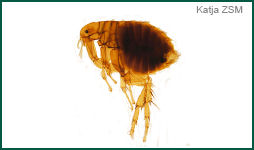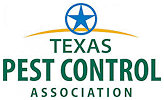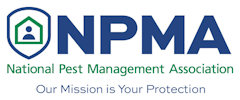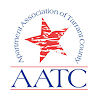Fleas and ticks are external parasites of pets, animals, and humans. Fleas are not only very annoying, but become very problematic to pets and homes if they infest it, due to being carriers of certain diseases. The tick is much more dangerous pest as they carrier diseases which can cause chronic illnesses such as Lyme Disease, and the Lone Star Tick can cause an allergy to red meat in humans.
Fleas
Fleas are wingless insects, 1/16 to 1/8-inch long, that are agile, usually dark colored , and have a proboscis, or stylet, adapted to feeding by piercing the skin and sucking their host's blood through their epipharynx. Flea legs end in strong claws that are designed to grasp a host. Their bodies are laterally compressed, permitting easy movement through the hairs or feathers on the host's body. The tough body is able to withstand great pressure, likely an adaptation to survive attempts to eliminate them by scratching.
Their legs are long, the hind pair well adapted for jumping; a flea can jump vertically up to 7 inches and horizontally up to 13 inches, making the flea one of the best jumpers of all known animals (relative to body size).
Fleas are vectors for viral and bacterial diseases of humans and other animals. Bacterial diseases carried by fleas include murine or endemic typhus, and bubonic plague.
Fleas are expensive if you have pets, as they live in pet’s fur causing them to be difficult to remove. Fleas eggs are also troublesome, because their eggs are nearly indestructible and resistant to many pest treatment products. However, the products that the Envirotrol's Flea Treatment Programs are labelled for fleas as well as their eggs.

Ticks
Ticks live by feeding on the blood of mammals, birds, and sometimes reptiles and amphibians. There are two types of ticks: the hard ticks, which are difficult to crush, and the soft ticks. Adults have pear-shaped bodies which become engorged with blood when they feed. Both families locate a potential host by odor or from changes in the environment.
Ticks tend to be more active during warmer months, though this varies by geographic region and climate. Areas with woods, bushes, high grass, or leaf litter are likely to have more ticks. Those bitten commonly experience symptoms such as body aches, fever, fatigue, joint pain, or rashes. People can limit their exposure to tick bites by wearing light-colored clothing (including pants and long sleeves), using insect repellent with 20%–30% DEET, tucking their pant legs into their socks, checking for ticks frequently, and washing and drying their clothing (in a hot dryer).
Ticks are implicated in the transmission of a number of infections caused by pathogens such as bacteria, viruses and protozoa. Tick-borne diseases in the Texas area include Lyme Disease, Colorado Tick Fever, Rocky Mountain Spotted Fever, Relapsing Fever, and Ehrlichiosis. Not all ticks in an infective area are infected with pathogens, and both attachment of the tick and a long-feeding session seem to be necessary for transmission of these diseases to take place.

FLEA AND TICK PREVENTION:
To effectively prevent flea and tick infestations, you must first understand their life cycle. They begin as eggs that are found in areas that are frequented by your pet, such as grass, carpeting, and furniture. These eggs hatch into larva, followed by the pupa stage (for fleas) or the nymph stage (for ticks), and then finish their cycle to adulthood. The female fleas and ticks then lay their eggs and the cycle begins anew.
Preventing flea and tick infestations includes minimizing or preventing the presence of eggs in your pet’s environment. Wild animals—such as raccoons, squirrels and skunks—can carry fleas and introduce them into your yard. A fenced-in yard can minimize the presence of these wild animals in your yard and thus minimize the presence of fleas and ticks.
Indoors, you’ll want to pay special attention to areas that are prime locations for fleas and ticks to be found. Prevent fleas from establishing residence in your home by treating your pet based on the treatment plan outlined on the flea preventative treatment you select. Also, be sure to wash your pet’s bedding frequently and be on the lookout for any signs of tick infestation.
Measure the efficacy of your flea and tick prevention and treatment regimen by regularly checking your pet for fleas and ticks. Use a flea comb to carefully examine your pet’s coat and check for the presence of fleas, then use your fingers to feel all over their body to thoroughly check for ticks. And even if you don’t find any fleas and ticks, be sure to look for other clues. Does your pet seem itchy? Are they scratching a lot? Do they have areas of hair loss or tiny specks (black or light-colored) on their coat? These symptoms can alert you to a flea problem and signal a need for additional treatment measures and preventative steps.
When recreating outdoors, wear long sleeves and pants, and tuck your pants into your socks. Stick to the middle of trails when hiking. Tick nymphs, the most common form to infect humans, are found in leaf litter, close to the ground. Insect repellent is effective. Try permethrin-based clothing or mosquito repellents with at least 30% DEET. Once home, check your skin immediately. Ticks like every part of the body, especially the hairline, ears, belly button, and groin area. Nymphs are very small, about the size of a sesame seed. They often look like a tiny dark freckle. Bathe within two hours of having been outside, and check your clothing and gear for ticks, too. Tumbling clothes in a dryer on high heat for an hour will kill any ticks you collected.
FLEA AND TICK TREATMENTS:
Treatment and management of fleas and ticks by Envirotrol Pest Management involves a number of steps. First, flea and tick infested pets should be treated with on-animal products. Ask your veterinarian for recommendations. Secondly, vacuum floors and furniture thoroughly and throw the vacuum bag out so as not to re-infest your home. Pay special attention to areas frequented by pets. Thirdly, wash all pet bedding in hot water, if possible. Fourthly, make all floor surfaces available for treatment.Envirotrol will use several products in its treatment protocol. Additionally, consider treating outside you home in areas frequented by your pets. Lastly, continue vacuuming regularly.
E-SYSTEMS USES IGR’s:
Part of the Envirotrol treatment protocol includes the use of an IGR (Insect Growth Regulator). IGR’s are products or materials that interrupt or inhibit the life cycle of a pest. Many people loosely use the term "birth control for fleas." If an animal cannot reach adulthood, it is not capable of reproducing. By inhibiting the maturity of the flea, it doesn’t reach adulthood, thus stopping the life cycle and infestation. Additionally, flea eggs and flea larvae that are exposed to an IGR won’t develop into the adult jumping, biting and (most important) reproducing fleas.




